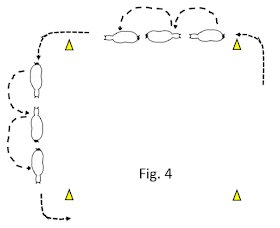Leslie asked about some ideas for Arena Patterns and I e-mailed her back saying that I really think given her imagination combined with what she thinks may help your horse, she could develop several patterns and drills, but I think that way of thinking will bring her back to the basics with her horse. What I have set up in my arena presently is just four traffic cones set up into a 40 foot square. I favor using props to set up patterns that give you many different options.
I recently finished giving a clinic on preparing your horse for an Arena Obstacle Competition where I encouraged those who attended not to get focused on training on carnival type obstacles, but instead to focus on controlling the four parts of the horse through basic maneuvers. Some of you immediately are taking issue with my "four parts of the horse" statement, believing that the head and neck are separate parts, combined with the front end, the barrel and the back end - making it five parts of the horse. And I am aware that my betters think differently, but in my experience, anything the head does effects the neck, and vice versa - I just don't think you can move the head independently of the neck, nor the neck independently of the head. I'll post an article in the near future on this.
Back to the Basic Square. I can get straight lines out of the sides of the square and bending out of the corners. I can ask a horse for softness in the straight lines, even a stop, back then forward movement again. I can use the corners to do 180, 270 or 360 degree circles - the 270 degree circles would be when you cross the diagonal. And sometimes, I'll add a stop, move the hindquarter 180 degrees, maybe a back up a few steps, then move the front end over 180 degrees facing the original direction of travel. So really what you can do is limited by your imagination. Having a pattern, and it's really just a guide, helps you focus, but a key to using it effectively would include be able to change up how you use it to keep your hose lively.
Figure 1. Using the square just to get the horse travel in a straight line, then bending around the corners. Variations could be: squaring off your corners; stopping and/or stopping with an immediate back up (this really helps your stop on your horse); or, leg yield to push the horse over to an inside line of travel;
Figure 2. Making a circles around a traffic cone the traveling across the diagonal.
Figure 3. Making complete circles around each corner cone. A variation would be to make a 180 degree forward circle, stop then back in 180 degree arc facing the original direction of travel then continuing.
Figure 4. On each straight line, stopping and disengaging the backend 180 degrees, backing up 3-4 steps, then bringing the front end over 180 degrees facing the original direction of travel. For the first time, be very deliberate and even slow it down, and maybe even pausing before each separate maneuver. This will help you horse get pretty handy as you are exercising control all parts of the horse.
Again, I would consider changing things up to keep your hose from getting dull or anticipating. example would be if you are doing full circles around each cone then maybe the skip the next cone just to keep your horse honest. Stopping between the cones and doing a roll back or doubling to the outside is another example of changing things up.








